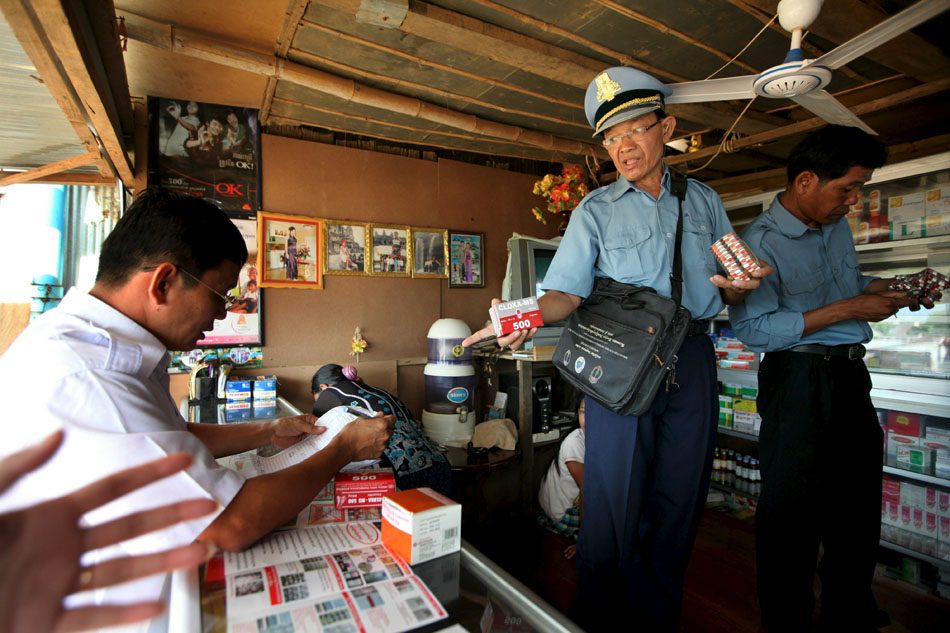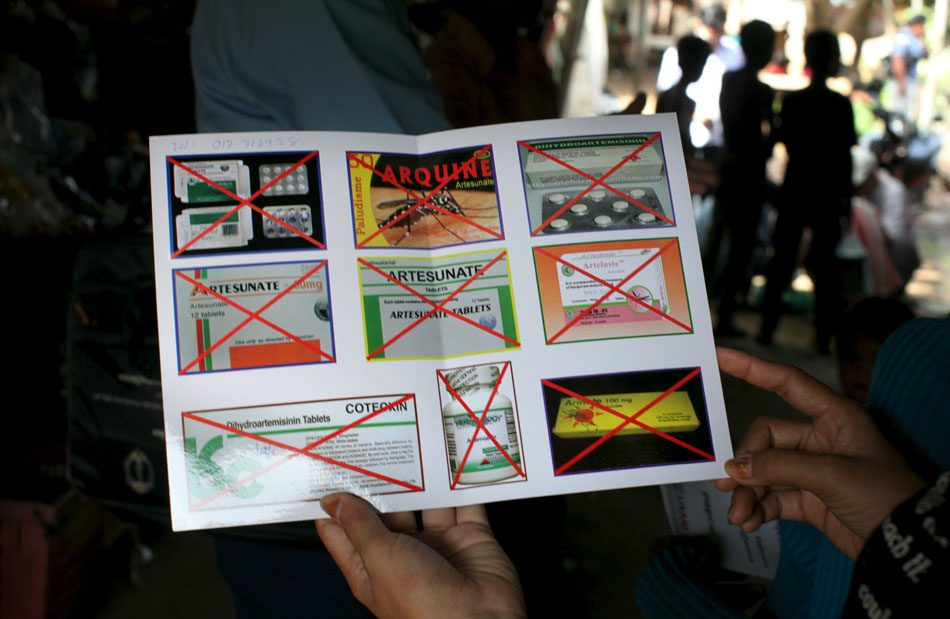Despite the best efforts of the authorities, producers of fake medicines are making a killing in Cambodia
By Sacha Passi
“Counterfeit medicine kills, while real medicine heals.” This was the simple but apt message selected just over a year ago for a poster campaign in Cambodia that aimed to raise awareness of the risks of counterfeit medications, as part of a government crackdown on the illicit trade.

Busted: Inspector Nuth Tith examines medicine in a pharmacy along the Cambodian-Thai border during a 2010 crackdown on counterfeit drugs
Record seizures of counterfeit medications in the country followed. On September 24, 2012, police appropriated more than two tonnes of dangerous medicines in Phnom Penh and arrested a pharmacy owner. A week later, three tonnes of counterfeit and expired medicines were discovered at warehouses in the capital’s Chamkarmon district – the largest counterfeit drug haul recorded in the country.
“Cambodia is a target for counterfeits because of the perception that it has a weak regulatory body. This is a misconception,” said Souly Phanouvong, manager of Asia Programmes for PQM, a USAid programme promoting the quality of medicines in developing countries. “Cambodia’s Ministry of Health… has become the most active regulatory body in the Mekong sub-region by shutting down the main sources of counterfeit medicines, including illegal pharmacies and health services that are not licensed to operate.”
Fraudulent drugs found in Cambodia are commonly sourced from China and India, the world’s top producers of substandard ingredients and fake-finished products. Counterfeit medication can be found in three forms: those that have insufficient amounts of the active pharmaceutical ingredient (API); those without any active ingredient; and those that have the wrong active ingredient. Fillers such as pesticides, rat poison, brick dust and floor polish, which have been found in laboratory tests of counterfeit medicines worldwide, pose as much of a risk to a person’s health as the wrong dosage of the API, said Harry Waskiewicz, the Asia-Pacific regional director of Pfizer Global Security.
“The danger posed by counterfeits is not limited to toxic ingredients… the ‘medicines’ themselves pose a threat to patients’ health and safety because their contents are not regulated,” Waskiewicz said.
The consequences can be deadly – particularly in a country still fighting to eradicate malaria-related fatalities.
The availability of free antimalarials at health centres, hospitals and designated malaria centres across Cambodia has no doubt contributed to a decrease in fatalities. Last year, 47 people died in the Kingdom from the mosquito-borne disease, a 50% drop from 2011 fatalities.
The free antimalarial programme is in place to ensure Cambodia’s most vulnerable have access to services likely to provide the genuine version of the most effective antimalarial drug, artemisinin, but ultimately its success in eradicating malaria is hampered by logistical challenges. Many rural patients cannot access official medical services because of poor roads and the high cost of transportation, forcing them to use alternative access points to medication.
“Malaria is an acute disease and people are often in a hurry when buying the medication. Although malaria can be fatal, most untreated cases are not, hence people assume the bogus medicine saved them and they may even be more willing to buy it again in the future,” said Roger Bate, an economist specialising in international health policy and counterfeit medicines with the American Enterprise Institute.

Dr Death: a brochure detailing banned medicines is found in Cambodia’s Pailin province
“Approximately 20% of the antimalarial medicines in Cambodia do not work. Many are fakes – sold because patients are not aware of the dangers. Additionally, most antimalarials make legitimate companies only a small revenue, so the companies don’t protect those brands as closely as they might more valuable products,” Bate added.
Between January and November 2012, approximately 63,000 cases of malaria were recorded nationwide – a drop of 35% compared to the same period in 2011. In Pailin, a western Cambodian province that neighbours Thailand, guarding residents from the disease is a growing challenge for health workers, who witnessed the number of malaria cases increase in the area last year.
Border provinces have a higher incidence of counterfeit and substandard medicines, and the prevalence of a drug-resistant strain of malaria is putting monumental pressure on provincial health organisations. It is a race against time for organisations working to reduce malaria cases and eliminate artemisinin-resistant parasites, as mutant strains have already appeared in Vietnam and Myanmar.
“Sub-optimal [or] small doses of the correct drug allows bacteria to develop resistance to that drug,” said Dr Gavin Scott, a travel doctor based in Phnom Penh. “However, I would guess counterfeit medicines are not the primary cause. A more important or, rather, more common challenge is how some people in developing countries take genuine medicines. They sometimes halve or quarter the tablets in order to share with other family members, and/or stop taking the drugs after two or three days when they feel better instead of completing the seven-day course.”
Studies by PQM show that the problem is far greater than the decreasing effectiveness of artemisinin: more commonly used medicines are also filtering into Cambodia’s counterfeit market.
“Unfortunately no medicines are immune to this problem and the focus of counterfeits can shift from one drug to another at any time. Antimalarials are often a target because of the high demand, but the current problem lies with counterfeit antibiotics,” said Phanouvong.
Amoxicillin and tetracycline, generally used to treat bacterial illnesses such as pneumonia, gonorrhoea and ear and bladder infections, are two of the most commonly found counterfeit antibiotics in Cambodia – a worrying development for the treatment of everyday ailments in the country.
Government crackdowns are no doubt welcomed and clearly needed in the Kingdom, but the weight of the issue goes beyond any record-breaking counterfeit busts when the health and lives of Cambodians are at risk.
“One has to trust the supply chain,” said Bate. “If it is weak, and I believe Cambodia’s is not as strong as it should be, there is always the risk that fakes will make their way to patients.”

